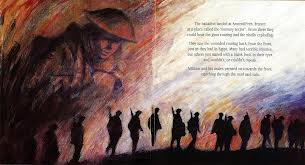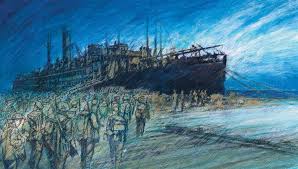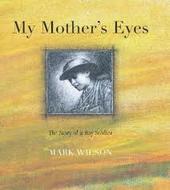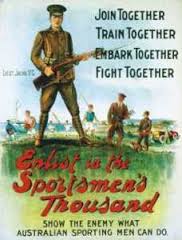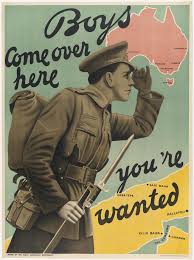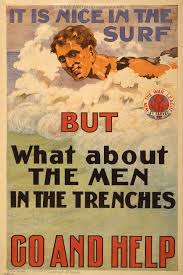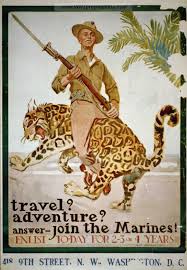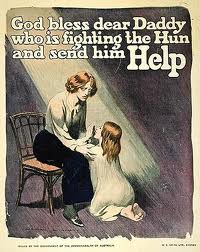Before Reading
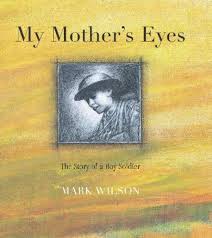
Look closely at the cover image. What do you notice about the boy in uniform in the frame?
He is young. How does he feel about going to war? Why do you think he feels this way?
Do you think this was typical of young boys during World War 1?
Why might this story be called, "My Mother's Eyes"? How does this title make you, the reader, feel?
This week our story takes us back to the battlefields of France and Flander's Fields where our story from last week was set.
He is young. How does he feel about going to war? Why do you think he feels this way?
Do you think this was typical of young boys during World War 1?
Why might this story be called, "My Mother's Eyes"? How does this title make you, the reader, feel?
This week our story takes us back to the battlefields of France and Flander's Fields where our story from last week was set.
Read the story
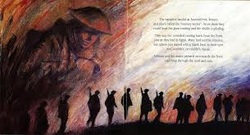
After reading discuss some of the following points:
THE LETTERS
THE LETTERS
- The story is told in two parts. The text is in third person telling the story and the second is a series of letters in first person from William to his mother. What did these letters tell you about William’s feelings? How do the letters make you feel compared to the text of the story? Why did the author do this?
- For example the first, sent from a camp in Australia, simply indicates the boredom of their routine training exercises, and a growing sense of camaraderie in playing cards together.
- The second is written from a ship during their evacuation from Gallipoli and hints at the danger in their situation but also at William’s continuing patriotism.
- The third is from the trenches in France, and in it William describes the plague of ‘flies, lice and fleas’, as well as the frostbite. But he also comments on the weather and the arrival of Spring, and observes the birds nesting amidst this mayhem with admiration, for William is a country boy at heart. The story then shifts at the end to a single scene showing the grandfather reading William’s final letter, and beginning to tremble... for the letter states that: ‘and should the worst happen I have had a good life.’ Does it make it clear to the old man that William is not coming home, without actually saying that in the text?
- This is a very dramatic way to end the story. Did you find it interesting? Or would you have liked more detail?
- The letters from the soldiers to home were not allowed to include details of what was happening in the war. Why do you think this was so? Was it a good thing for the families ?
- Question: William’s letters hint at his fear but he obviously tries to put a positive light on the situation. Do men today still cover up their feelings, in order to put on a brave face? Or are they more in tune with their emotions?
- THE ILLUSTRATIONS
The cover of a book is an important part of its message. Read the cover and discuss its
impact.
Discussion Point: The title page of the book ‘sets the scene’ with a picture of an iconic digger
with his slouch hat. This and later pictures are reminiscent of the works of war artists trying to
capture the essence of a scene; the action; the mood or feeling; the boredom and the chaos of war.
Discuss the impressions each painting in the book gives you.
Discussion Point: The format of the book is square in shape, and the layout of the storyboard
contains largely double page spreads which depict landscapes at home and abroad, although the
images are arrestingly vague in detail. How does the format of, and design of the book, influence
your reading of it?
The medium or style employed is oil painting on canvas. The paintings are in turn a
mixture of detailed landscapes, moody portraits, and impressionistic abstracts of the chaotic
scenes of war. Try to create your own painting in this medium, depicting some scene suggested by
this text.
Question: Colours used in this book are muted and sombre. How does colour affect your
interpretation of this work?
Discussion Point: Images of war are starkly defined in these pictures–poppies, barbed wire,
medals, crosses etc. What do these symbolise?
impact.
Discussion Point: The title page of the book ‘sets the scene’ with a picture of an iconic digger
with his slouch hat. This and later pictures are reminiscent of the works of war artists trying to
capture the essence of a scene; the action; the mood or feeling; the boredom and the chaos of war.
Discuss the impressions each painting in the book gives you.
Discussion Point: The format of the book is square in shape, and the layout of the storyboard
contains largely double page spreads which depict landscapes at home and abroad, although the
images are arrestingly vague in detail. How does the format of, and design of the book, influence
your reading of it?
The medium or style employed is oil painting on canvas. The paintings are in turn a
mixture of detailed landscapes, moody portraits, and impressionistic abstracts of the chaotic
scenes of war. Try to create your own painting in this medium, depicting some scene suggested by
this text.
Question: Colours used in this book are muted and sombre. How does colour affect your
interpretation of this work?
Discussion Point: Images of war are starkly defined in these pictures–poppies, barbed wire,
medals, crosses etc. What do these symbolise?
Something to debate
Look at some of the recruitment posters above, used during the war. Who did they appeal to? What 'tricks' did they use to appeal to the young men to enlist? Did the authorities willingly
turn a blind eye to the age of many who enlisted? Were boys like William brave to enlist, or were
they duped by propaganda and the pressure of peer expectations?
turn a blind eye to the age of many who enlisted? Were boys like William brave to enlist, or were
they duped by propaganda and the pressure of peer expectations?
